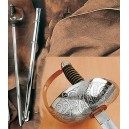No products
Sabres
- Legendary Swords
- Samurai Swords
- Cold Steel Katana Swords
- SkyJiro Forge Katana Swords
- Thaitsuki Swords
- Citadel Katana Swords
- Dragon King Samurai Swords
- YariNoHanzo Katana Swords
- Imperial Forge Katana Swords
- Musashi Katana Swords
- Cheap Samurai Swords
- Katanas
- Military Gunto
- Shirasaya
- Tachi
- Wakizashi
- Tanto
- Sword Sets
- Weapons
- Custom Katana Swords
- Kaneie Samurai Swords
- Samurai Armor
- Sword Deals
- Battle Ready Swords
- Damascus Swords
- Celtic Swords
- Chinese Swords
- Civil War Weapons
- Conan Swords
- Fantasy Daggers
- Fantasy Swords
- Fencing Sword
- Military Swords
- French Napoleonic Saber Swords
- British Swords and Sabers
- German Swords
- Czech swords
- Polish Swords
- Russian Swords and Sabres
- Greek Swords
- Arabic swords
- Kit Rae Swords
- Knights Templar
- Knives
- LARP Swords
- Limited Edition Swords
- Masonic Swords
- Medieval Armor
- Medieval Costumes
- Medieval Daggers
- Medieval Swords
- Medieval Weapons
- Miniature Swords
- Movie Swords
- Lord of The Rings
- Hobbit Replicas
- Game of Thrones
- Highlander
- Vikings Weapons
- Walking Dead Swords
- Alexander Swords
- 300
- Assassin's Creed
- Braveheart
- Eragon Swords
- Excalibur
- Gladiator Swords
- Hercules Swords
- Xena Swords
- Kill Bill Swords
- Peter Pan Swords
- Rambo Knives
- Robin Hood Swords
- The Last Samurai
- Zorro Swords
- Terminator
- Princess Bride
- Zombie Weapons
- 47 Ronin Swords
- Expendables
- Predators
- Alien Weapons
- Immortals
- Snow White And The Huntsman
- Ninja Swords
- Pirate Swords
- Practice Swords
- Rapiers
- Roman and Greek Armor
- Roman Swords
- Sabres
- Scimitar Swords
- Spears and Lances
- Special Medieval Stuff
- Sword Display Stands
- Sword Letter Openers
- Swords of Justice
- Viking Swords
- Walking Canes
- Warriors
- Western Gun Knives
- Wooden Swords
- Replica Guns
- Ranged Weapons
- Antique Swords
- Damascene jewelry
- Film Cells
- Fantasy Prints
Cold Steel Talwar-Indian Saber
88EIT
New product
Cold Steel Talwar-Indian Saber 88EIT. Famous oriental saber used in India, derived from Mongol (Mughal) sword. Talwar (tulwar) is the famous oriental saber used by western armies.
Ships in 5-10 day
More info
Cold Steel Talwar-Indian Saber 88EIT
For over a century, most of the Western world has remained convinced that a point-oriented, thrusting sword is superior to an edge-oriented cutting sword. There are, however, a series of books by D.A. Kinsley that cast a skeptical light on this running debate. Kinsley recounts numerous incidents (collected form battlefields throughout the British Empire) where cutting swords proved equal, if not superior, to thrusting swords in deciding the outcome of a skirmish.
Our President, Lynn C. Thompson was encouraged by Mr. Kinsley's ideas and after considering all the evidence decided to produce one of the best cutting swords ever devised: The Indian Talwar.
Taking a cue from the most experienced Indian Swordsmen of the past, and the Pindari chief of old, Amir Khan, Lynn has combined a strongly curved British Light Cavalry blade with its distinctive hatchet point (wider near the tip than the forté) with a traditionally styled Indian hilt.
The blade is hand forged from tough 1055 Carbon steel and features a broad fuller and a razor edge. The hilt is equally well made. Fashioned from brass with an intricately decorated surface, it offers short, thick quillons, a single knuckle bow and the traditional dish shaped pommel to lock in your hand.
Supplied with an excellent scabbard made of wood covered in black leather and capped at either end with a thick brass throat and chape, our Indian Talwar is a ferociously effective cutting sword that will serve you well on or off the battlefield.
Talwar features
Blade Length: 33"
Overall Length: 39"
Steel: 1055 Carbon
Weight: 47.6 oz
Handle: 6"
Scabbard: Leather / Wood Scabbard with Brass Fitting
Talwar has a wider blade than the shamshir, and lacks the expanded yelman (false-edge) of the kilij. Late examples often had European-made blades, set into distinctive Indian-made hilts. The hilt of the typical talwar is termed a "disc hilt" from the prominent disc-shaped flange surrounding the pommel. The pommel often has a short spike projecting from its centre, sometimes pierced for a cord to secure the sword to the wrist. The hilt incorporates a simple cross-guard which frequently has a slender knucklebow attached. The hilt is usually entirely of iron, though brass and silver hilts are found, and is connected to the tang of the blade by a very powerful adhesive resin. Superior examples of the tulwar often show silver or gilt decoration in a form called koftigari.
Talwar - oriental saber.
































